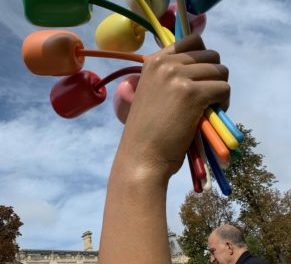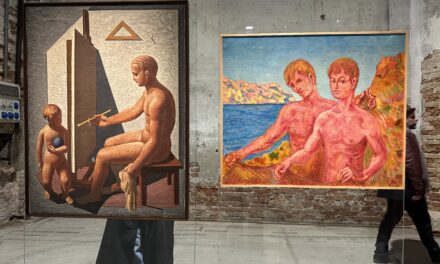Imbibing what is happening
Like everyone, I arrive at an exhibition and I wonder what there is to see. In certain cases, an opinion forms immediately. Photos, sculptures, paintings, installations and films allow their stories to spontaneously unfold. Other times, it’s best not to jump to conclusions about what is being presented. It’s worth just observing, allowing yourself to slowly but surely imbibe what is happening.
Luma Foundation

This is the approach to take at the exhibition of the work of Theaster Gates (born in 1973) taking place at the Luma Foundation in Arles in South of France. In a huge old renovated warehouse the Chicago-based artist has staked out a space to immerse us in his world. Strongly influenced by Japanese culture, he has given the project a title taken from the language of the country: Min/Mon. Min for the people. Mon for the gate. But in French, ‘mon’ also means ‘my’.
Theaster is the art
After careful consideration, having visited his vast exhibition at the Palais de Tokyo in Paris in 2019 (See the report here), and his “Black Madonna” exhibition at the Kunstmuseum in Basel in 2018, having recently viewed his three films exhibited in Venice (see the report on the Venice Architecture Biennale) I must admit that the art is Theaster Gates himself, much more than a room filled with objects. The artist, who always dresses with care, is a kind of African American Joseph Beuys for the 21st century. He didn’t fall from a plane to be saved by a group of Tatars. It was the Japanese from the town of Tokoname, who used six ancestral kilns to produce their ceramics, who “saved” the young boy .
Like Beuys
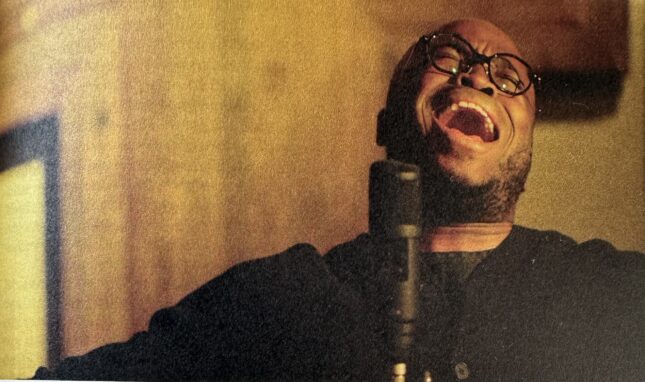
Theaster Gates
Like Joseph Beuys, he is a kind of preacher, a politician in the Greek sense of the term. He is a poet, a musician and also, naturally, a sculptor. He doesn’t reject artistic references from the past: “When I’m thinking about my place in art I’m always thinking about Joseph Beuys, Louise Nevelson (See here the Louise Nevelson exhibition during the last Venice Biennale), Louise Bourgeois (See here the exhibition on Louise Bourgeois at the Kunstmuseum in Basel), Joseph and Annie Albers (See here their exhibition at the Musée d’art moderne in Paris), the Bauhaus, Black Mountain College, Kerry James Marshall (See here the report on the Kerry James Marshall retrospective), Carrie Mae Weems (See here the report on the Carrie Mae Weems exhibition), Thelma Golden (See here the report on Thelma Golden).
The ghosts
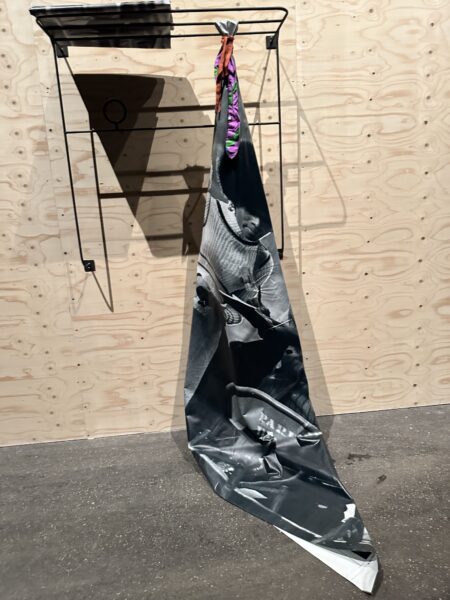
I’m also thinking about Clement Greenberg because understanding art history is important. My life is constantly acknowledging the ghosts of the past. Marcel Duchamp is one of the most significant members of the ghosts.”
Afro-Mingei
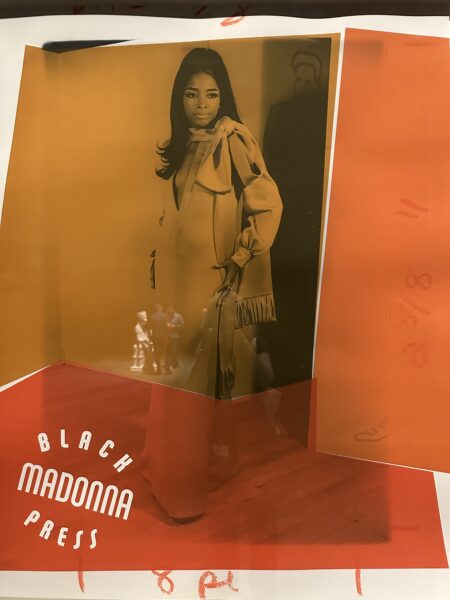
In Arles he has created a space that is both intriguing and welcoming, open to influences. He talks about Afro-Mingei (Mingei is a Japanese artistic movement, a kind of arts & crafts that spotlights the country’s artisanal skills).
In a large room with wooden floorboards taken from an old chewing-gum factory in the city where he was born, we can listen to music from one of the 2500 discs in his personal collection. “I take soul, funk gospel, jazz everywhere I go.” DJ Theaster is as though in levitation, hyper-focused. We can also, in this space, try some free sake from Tokoname.
Sake from Tokoname

“I made a sake because in this town some friends had a great sake factory and I really wanted to find ways to celebrate, to bring Tokoname to the world, but also to celebrate what Tokoname does well. They have great potters and great sake. I’m so curious about whether we could make a distilled beverage from the rice of Camargue.”
Whitney Biennial 2010
In terms of the décor, he had already used these small floorboards at his installation at the Whitney Biennial in 2010, the event that brought him international renown. “For the Whitney Biennial I created a shoe-shine temple. Here it’s more like a listening temple. It’s nice to have these 13 years between then and now, and to have this material manifest again. The neighbourhood where I grew up in Chicago is on the West Side, Garfield Park.”
Industrial feeling
In the large warehouse, a film projected on a big screen takes over the space. In it, we see Theaster wandering through a deserted factory. “It’s a salute to Japanese poetry and gospel music. I basically combine these two forms and I kind of made a blues about nature. It was made at a former brick factory in Montana. The brick factory has the same kind of industrial feeling. I thought if I could put a former brick factory inside a former factory, that would be beautiful. It’s a salute to the work that happened here.”
Social sculptor
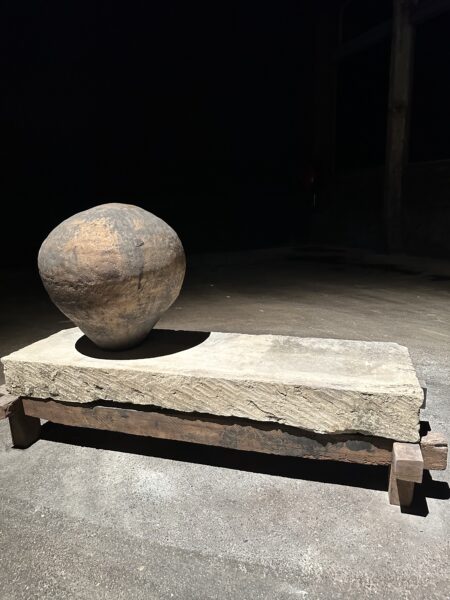
Theaster Gates is a “social sculptor”, as is said about Beuys, and his oeuvre is revealing in how it addresses his family life, and his father who worked as a roofer in Chicago. I asked him about himself in order to better understand his creation.
INFLUENCES
How did your mother influence you?
“She had the ability of making things work with love. For Christmas I was given a video game. I already had an early version of video games. I didn’t want my niece to play. I wanted my friends and me to play. My mum came to my room, unplugged the video game, and gave it to my niece, and she didn’t give it back to me. I think I’m still upset about it. My Mum knew a lot about the habits of selfish people. At a very early age it seemed I had a lot of more privilege than my niece, and she helped me to understand that in the house there was no privilege, and that the more you give the more you get.”
How did you father influence you?
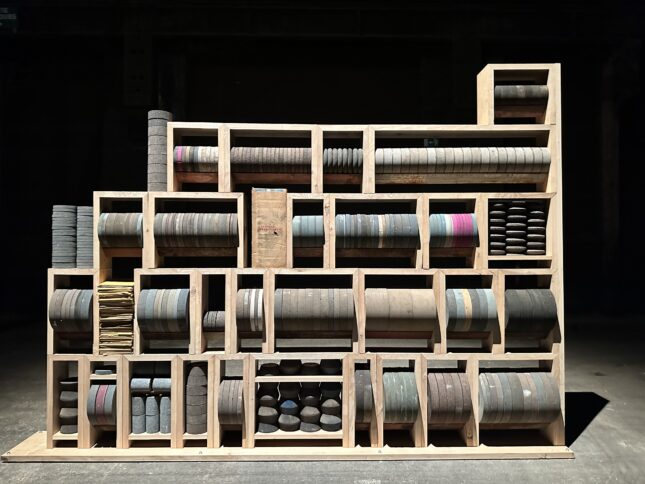
“The reason I talk about my father is because my mum asked me to speak about him. When she was dying she said, “Forgive him, love him, honor him. Take care of your sisters. I’ll do the rest”. And then you know, she has done the rest. I would not be here today if she would not have said that. I was already in my 30s. It was necessary for me to hear that.
I have my dad’s tar kettle here, the tool that we used when we were roofing together. He had it for 20 or 30 years and when he was getting older he gave it to me. I thought: ‘what am I going to do with this? It’s not an inheritance that has any value’.
Through my dad’s demonstration of working hard, leaving the house at 4 in the morning and coming home at 3, taking a nap and doing his second job and then doing it all over again… He had a double working life in order to pay for the needs of his family and then work toward economic freedom for himself. His night job gave him the freedom to be an entrepreneur. And we are talking about 12 or 15 bucks an hour for a 50-year-old man. That discipline allowed him to quit his job and have a liberated life. He was a hard worker and he taught me to work hard.
The readymade here is a trace, it’s not from a random place. At any point I can activate it. Symbolically, to fix a roof is about having the skills that preserve the things under the roof.”
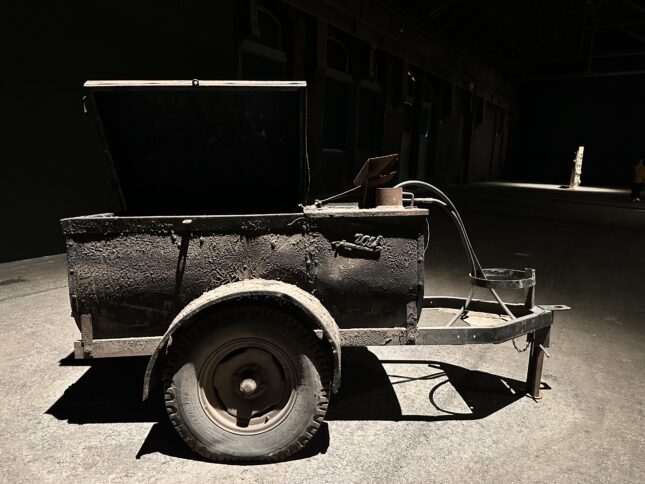
How has Chicago influenced you?
One of the biggest things that Chicago is giving me is time away from the light, away from the public. A fertile soil. It’s an affordable city, a place where I can grow and dream and there is no one to interfere with my dreams. It really has been a place of abundance for me. I’m grateful for that. But it’s also a place where there is a place for everyday people who really matter. I’m always thinking about the schoolteachers in that city, the laborers, the power of our laborers. When the Mexican community decides it’s not going to work for a day the city shuts down. That’s the tremendous amount of respect I have for Mexican workers in Chicago. My project in Chicago was simply to take the lack of investment and the buildings in the neighborhood where I lived and try to use my influences and resources to make this small area, 4 square blocks, better. And over 16 years we were able to make a neighborhood that is now an important place for artists and creatives, a safe place for the queer community, and gather spaces for everyday people.
Kerry James Marshall lives not far away from here. There are great artists in Chicago. Nick Cave is there, Candida Alvarez is a beautiful woman…”
How has Japan influenced you?
“You can live a singular life if you can devote yourself to a thing, and that thing will give you back many gifts. My life has always been to do different things: poet, writer, singer… But Japan taught me it’s ok to have one quiet passion. And to do it with full intentionality, full belief. Through ceramics, it’s like Japan gave me my hands. This room is the result of learning a lot from the Japanese, which means they are also Chinese and Korean and Taiwanese. Japan is also this interesting amalgam of philosophical and spiritual ideas.
I studied ceramics in Tokoname in Japan, starting about 20 years ago.
My ceramic instructor from my undergraduate degree wrote a letter for me to a ceramic Japanese homestay and when I was in my 20s I went to study and kept going back to this small town. I knew Tokoname way before I knew Tokyo and Kyoto and Hosaka. I just like to take the train to my town. And it’s just great. For me it was an adjustment, but I think this small town felt more like Mississippi where my parents are from. It was familiar and an easy adjustment.”
How did the 2010 Whitney Biennial influence you?
“A really wonderful person was the curator of this Biennial, Francesco Bonami (see a video interview with Francesco Bonami on the American artist Kaws). Francesco saw my house in Chicago and the project I was doing and he said: ‘I’m going to give you the courtyard of the building.’ This guy that I talked to for 2 hours trusted me with this huge space and I thought: let me work as hard as I can to make something very beautiful.
I was 24 when I was invited and it was the first time I had an exhibition outside of Chicago.”
What is your next dream?
“I want to be a potter again. I will go back to Japan. Now Chicago is with me in my heart, maybe it’s also with me in my albums.”
Support independent news on art.
Your contribution : Make a monthly commitment to support JB Reports or a one off contribution as and when you feel like it. Choose the option that suits you best.
Need to cancel a recurring donation? Please go here.
The donation is considered to be a subscription for a fee set by the donor and for a duration also set by the donor.

